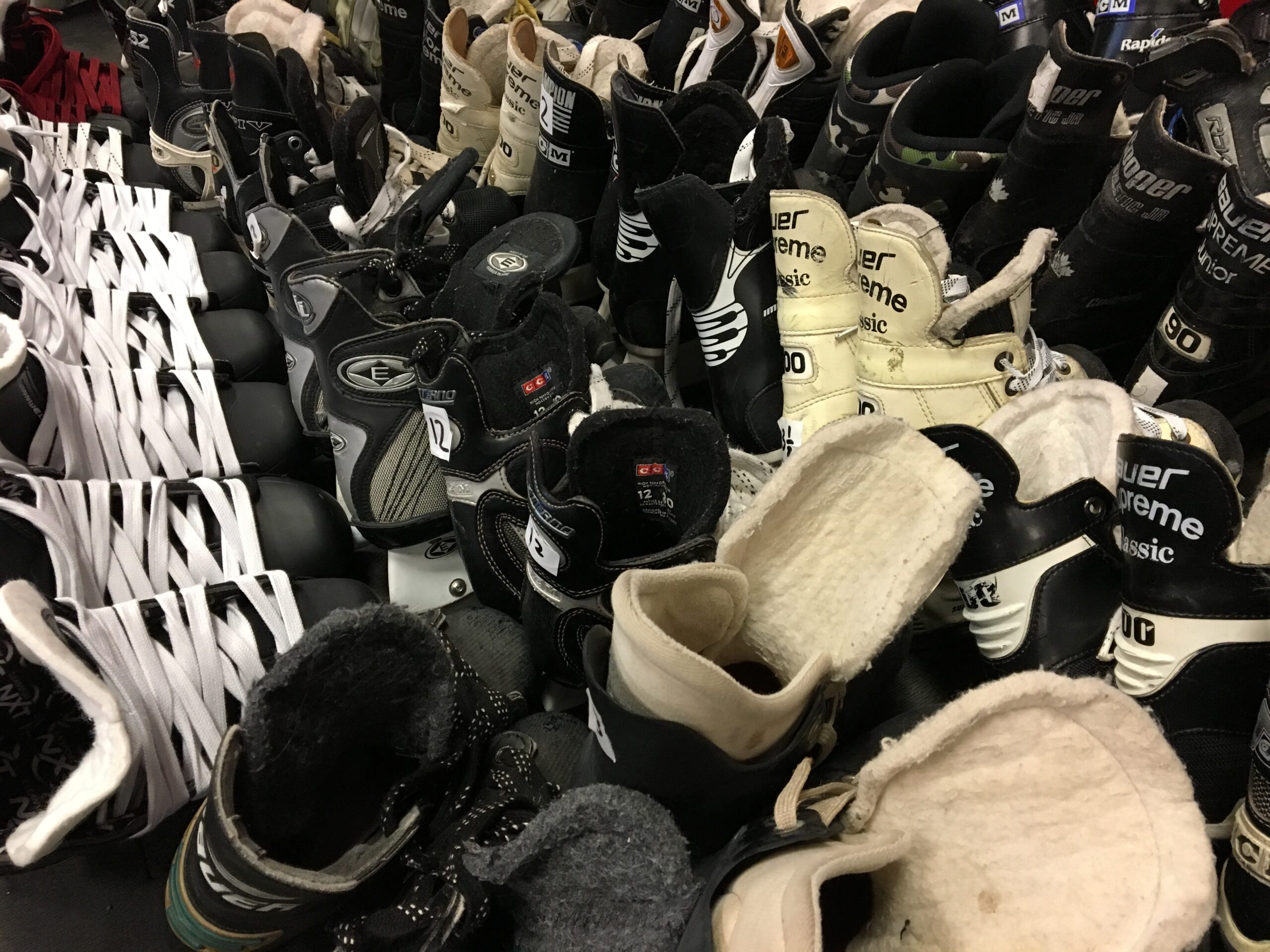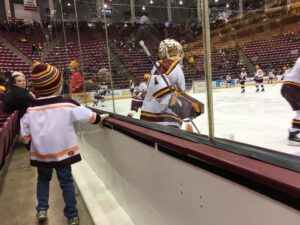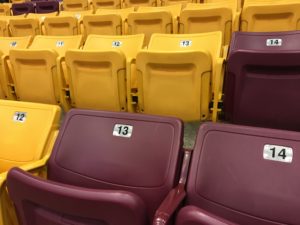
I recently saw a fight at a college hockey game. No penalties were assessed—it was a Politeness Fight. Parents stood nearby, watching their kids shoving… the puck into each other’s hands. “Here, you take it,” said one boy. “No, I already have a lot,” said the other. “You take it.”
Brutal. Two minutes, hand-holding.
See, during warm-ups before the game, a kind-hearted player had flipped a puck over the glass, toward my son. It sailed over my son’s head, up a few rows of seats, and another boy dived to grab it. That boy’s father, apparently a bit embarrassed by the show of not-so-passive aggression, insisted that his son give the puck to its intended target; the boy obeyed and meekly offered the puck. But my son, no stranger to getting pucks flipped his way, met his insistence and raised him one: he said that the boy should keep it. A moment of awkward, social-norms-have-failed-us silence ensued before both kids returned to watching the players, politely standing next to, but not against, the glass, while my wife and the boy’s father exchanged pleasantries after their attempt to assimilate the next generation of Minnesota Nice—on Ice.
Welcome to college hockey.
Well, it’s Minnesota Nice in the stands, anyway—gameplay among armored, blade-footed, stick-wielding young men is much less polite, of course. But the crowd at a college hockey game, especially during warm-ups, can feel like a mix of cocktail hour and PTA meeting, seasoned with a tablespoon of country club for good measure.
This description might not fit the stereotype of hockey fans in general, but the stereotypical hockey fan isn’t at a college game, either. He’s probably watching the NHL, or some minor-league slugfest, or yelling at the refs at his son’s Bantam tournament. Instead, the typical college-hockey fan went to… college, usually at the home-ice school. And graduated, even—why else would he come back? He can also afford hockey tickets, and for his two kids, too. He might be wearing a $150 hockey jersey (or “sweater”), maybe with his own last name custom-embroidered on the back. He might have a craft beer in his hand, eyes fixated on the game, absent-mindedly shushing one of those whiny, upper-middle-class kids who can’t navigate a six-dollar hot dog. And yes, maybe he’s had a couple of those beers, but he hasn’t been tailgating in the heat all day, as might be part of the package at a football game. So sure, things can get heated in the crowd at a college-hockey game, and there are dicks everywhere, but most Midwestern college hockey is a pretty tame affair, all things considered.
Outside of the student section, that is. The description of college-hockey fans thus far might conjure images of tennis, or maybe croquet, senior circuit. But college students find their way to one end of the arena, often in some state of chemical alteration, and they tend to make enough noise for everyone. This noise typically includes prescribed chants, sometimes before the game starts (e.g. immediately after the opposing head coach is introduced, a thousand pre-med and pre-law majors—rarely the art-history majors, for some reason—shout “Nice tie, Asshole!”). So, decant all of the crudeness that you associate with adult hockey fans, mix it in a red Solo cup with Milwaukee’s Best Light or a rum-and-diet or whatever pomegranate-infused seltzer-nonsense that college girls drink these days, and you have yourself a party on ice. Or just on the other side of the glass, anyway. It evens out.
Also, there’s usually a band. Outside of Madison Square Garden, most NHL and minor-league and junior teams rely on the thumping of stadium hip-hop-pump-rock to break the media-timeout silence; in college hockey eight trumpets and six trombones and two bewilderingly obligatory flutes try to keep time with the echoes of flogged drums. School songs are played, during which a dozen or so girls skate in an over-practiced routine while wearing identical dress-skirts over identical nude tights, matching their nearly identical but slightly-darker-than-the-ice skin. These cheerleaders are a bit less perky than those for football or basketball games—after all, at any time they might fall over, and the concentration of skating in unison, and intercalating with another line of skaters, can-can style, seems to sap some of the proto-stripper qualities that too many college squads seem to foster these days.
It all has the feel of, say, as if a well-funded high-school pep fest broke out in the middle of a country-club fundraiser on a winter night in Minnesota. Which, I guess, on some levels it is.
But some of those country clubs are nicer than others. In this way college hockey has an element of diversity that other sports lack, which is an odd thing to say about a sport that’s about as uniformly white as the ice. But hockey is a bigger deal at some schools than it is at others. This is true of football and basketball, too, of course, but there’s another level to it: because so few schools play hockey—sixty schools play Division-I hockey, compared to over 300 in D-I basketball—comically mismatched schools can find themselves playing each other just to fill the schedule.
As a silly, minor example to illustrate the point, consider the bands. At big schools—schools who belong to conferences that you’ve heard of, like the Big Ten—the hockey pep band is usually selected from the football marching band, whose members number in the hundreds, plural. And that marching band is expected to be damn good: every other Saturday for a couple of months, it’s trotted out in front of tens of thousands—sometimes over 100,000—fans, and embarrassment is not an option. These guys have daily rehearsals, two-a-day practices at preseason Spat Camp, new uniforms, fleets of buses for trips across states to other Big-Ten schools for away games, etc. So when a few of the better ones get together to play “Hang On Sloopy” in the top rows of your local rink in the winter—not marching, just standing in matching polo shirts (or oversized jerseys for the tubas), with no one’s hat being blown off by the wind—they manage just fine, thank you.
Contrast that crew with the band from a small regional school that plays… not major-conference Division-I football, not mid-major Division-I football, and not even Division-IAA (FCS) football… but Division-II football, where the marching band, if there is one, has to perform in front of maybe a couple thousand people—for homecoming—and you’ve got a mismatch. That’s an understatement, usually. Same with the cheerleaders, if there are any. It can all take a decidedly high-school flavor very quickly. Just sayin’, semi-empirically.
None of this necessarily translates to the product on the ice, of course. (Two-time defending men’s hockey champion University of Minnesota—Duluth, a school that plays other sports in Division II, comes to mind.) But differences still run deep. There’s kind of an inverse relationship, actually, where the Division-I hockey players at the small school are immediately the big men on campus, and the most visible program on campus, just because they play a D-I sport, regardless how well. At the big school, hockey players aren’t nobodys, but when ESPN comes to campus, it’s not for the hockey game. Hockey is the smaller fish in the big school’s pond, almost automatically.
Money and logistics differ, too. The athletic director at Minnesota—Duluth, for example, probably has to center his budget on his men’s hockey team, which is his only Division-I men’s program. At the state’s flagship school, though, which plays football and basketball in the Big Ten, the entire hockey program’s budget isn’t quite a rounding error, but it’s close. This can matter for the fans. If a football game falls on the same day as a hockey game, UMD doesn’t worry—the football game is during the day, and local television will carry both. The big school’s AD, though, has to worry about the Big Ten Network, and will probably have to reschedule something, and the number of tickets sold and the television contract means that that something won’t be football. Or basketball, for that matter. As an afterthought, during the football game he might—might—ask someone to check the hockey score. Between hot-dog runs.
Even the mascots and logos are different. The big-time schools have national brand recognition, and their logos have the stately, time-honored feel that comes with being around for over a century. Michigan’s block M, for example. Minnesota’s really block M, as another. Wisconsin’s newer, oddly splayed W, even. These are in stark contrast to smaller schools’ logos and uniforms, which are less stately, not just because they’re often newer, but because they can have so many letters and directions and hyphens to accommodate. University of Minnesota—Duluth. UMass—Lowell. Northern Michigan. Lake Superior State University. That’s hard to condense into a single-letter logo. Or to fit in diagonal letters across the sweater, even on the goalie.
This is not to poke-check fun at anybody’s hockey program—the University of North Dakota, for example, plays third-tier football but plays top-tier hockey in a huge, sold-out, state-of-the-art facility in Grand Forks—but instead to highlight the natural David-and-Goliath stories that hockey, and only hockey, has to offer. It’s part of the fabric of the sport (even if less so these days after the aforementioned television network forced consolidation of some of the big schools into a single conference). In what other sport can the regional school compete with the flagship? I mean, not just play them, but actually compete with them? What other sport pits alumni of the University of Somewhere against the alumni of the University of Somewhere—Nowhere? It’s a beautiful thing.
Like what happened during the first intermission of that recent college hockey game. That boy who “took” the puck from my son (twice)? He and his father stopped by our seats after getting popcorn. The boy handed my son a souvenir stick-and-puck set. The dad just nodded, smiling.
The next generation of Minnesota Nice—on Ice. A beautiful thing, indeed.

P. A. Jensen (@RuralityChecker) is editor of RuralityCheck.com.
He lives in Minnesota with his wife and son.



